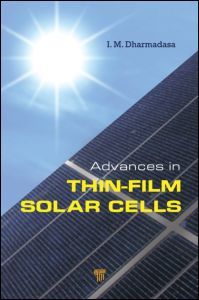Description
Advances in thin-film solar cells
Author: Dharmadasa I. M.
Language: English
Subjects for Advances in thin-film solar cells:
Approximative price 142.05 €
In Print (Delivery period: 13 days).
Add to cart300 p. · 15.2x22.9 cm · Hardback
Description
/li>Contents
/li>Readership
/li>Biography
/li>
Preface
List of Symbols and Abbreviations Used in the Book
Photovoltaic Solar Energy Conversion
Introduction
Photovoltaic Effect
Solar Energy Materials
Electronic Devices Used for Solar Energy Conversion
Characteristics of a Solar Cell
Next-Generation Solar Cells
Summary
Status Report on Solar Energy Technologies
Introduction
Si Solar Cell Technology
PV-Manufacturing Cost Based on Si Technology
PV Technology Based on III-V Compounds
New Technology for PV and Nano-Divices
Emerging Low-Cost Thin-Film Technologies
Summary
Electrochemical Deposition of Solar Energy Materials
Introduction
Electrodeposition of Semiconductors
Strengths and Advantages of Electrodeposition
Experimental Evidence
Issues in Electrodeposition of Semiconductors
Current Work and Future Prospects
Summary
Background of the CdTe Solar Cell and the New Device Concept
Introduction
The Conventional Model for a Glass/Conducting Glass/CdS/CdTe/Metal Solar Cell
Key Observations That Led to the Formulation of a NewModel
New Concept for CdS/CdTe Solar Cell
Description of Experimental Results Using the Two Models
Predictions for Further Development of CdS/CdTe Solar Cells and Latest Observations
Summary
Extension of the New Model to CIGS Thin-Film Solar Cells
Introduction
Summary of Accumulated Knowledge on CIGS-Based Materials
Summary of Accumulated Knowledge on CIGS-Based Solar Cells
Current Views of the Physics Behind CIGS Solar Cells
Reported Device Performance
RecentWork on Metal/p-CIGS Interfaces
Deeper Understanding of Mo/CIGS/CdS/i-ZnO/ n-ZnO:Al/Metal-Grid Solar Cells
Discussion on Further Improvements of CIGS Solar Cells
Conclusions
Summary
Effective Harvesting of Photons
Introduction
Tandem Solar Cells
Comparison of the Two Connecting Methods
Conclusions
Summary
Multi-Layer Graded Bandgap Solar Cells
Introduction
Summary of Growth and Process Details of the Device Structure
Experimental Results of Fully Processed Devices
Discussions
Summary
Solar Cells Active in Complete Darkness
Introduction
Summary of Experimental Results
Search for Experimental Evidence of the Impurity PV Effect
Responsivity Measurements
I-V Measurements Under Dark Conditions
Discussion
Conclusions
Summary
Effects of Defects on Photovoltaic Solar Cell Characteristics
Introduction
Variations of I-V Characteristics of Metal/n-CdTe Interfaces
Effects on the Performance of CdS/CdTe Solar Cells
Variations in GaAs/AlGaAs Solar Cells
Variations in CIGS Solar Cells
Summary
A Future Dominated by Solar Energy
Introduction
Early Applications with Low Power Requirements
Early Applications with Moderate Power Requirements
Applications in Solar Home Systems (∼50WRange)
Applications in Drip Irrigation Systems (∼100WRange)
Applications in Powering Computers (500–1,000WRange)
Applications in Large-ScaleWater Pumping (∼1,000Wand Above)
Solar Power Applications on Roads
Solar Power Applications on Buildings (∼3 kW and Above)
Energy from Solar Farms and Deserts (MW Range)
Recommendations for Developing Countries
Recommendations for Developed Countries
Summary
Is Fermi-Level Pinning Affecting GaAs-Based Solar Cells?
Introduction
Observation of Discrete Sets of I-V Characteristics
Observation of Discrete Sets of Voc Values
Discussion of New Observations
Thoughts on Future Directions of Thin-Film Solar Cell Research and Development
Introduction
Areas for Research and Development Efforts
Conclusions
Index
I. M. Dharmadasa has worked in semiconductor research since becoming a Ph.D. student at Durham University in 1977. His interest in the electrodeposition of thin-film solar cells began when he joined the Appolo Project at BP Solar in 1988. He continued this area of research on joining Sheffield Hallam University in 1990. He has 80 refereed papers, six patents and over 100 conference presentations, and five book contributions, and he has successfully supervised 10 research degree candidates and nine years of PDRA support. He has gained research council and internal University funding and is currently working with a group of industrial partners (Ionotec Ltd, Pilkington plc, and ICP Solar UK) to commercialize the new research findings with the UK Government’s DTI-funding.
Dharmadasa is also actively involved in the public awareness work on applications of renewable energy in the society. He was the key person in initiating SAREP (South Asia Renewable Energy Programme), which is now becoming an international programme for the promotion of renewables. He is the editor of SAREP newsletter and has designed a "Village Power" programme using solar power to empower rural communities for the reduction of poverty.
These books may interest you

Advances in Thin-Film Solar Cells 143.25 €


